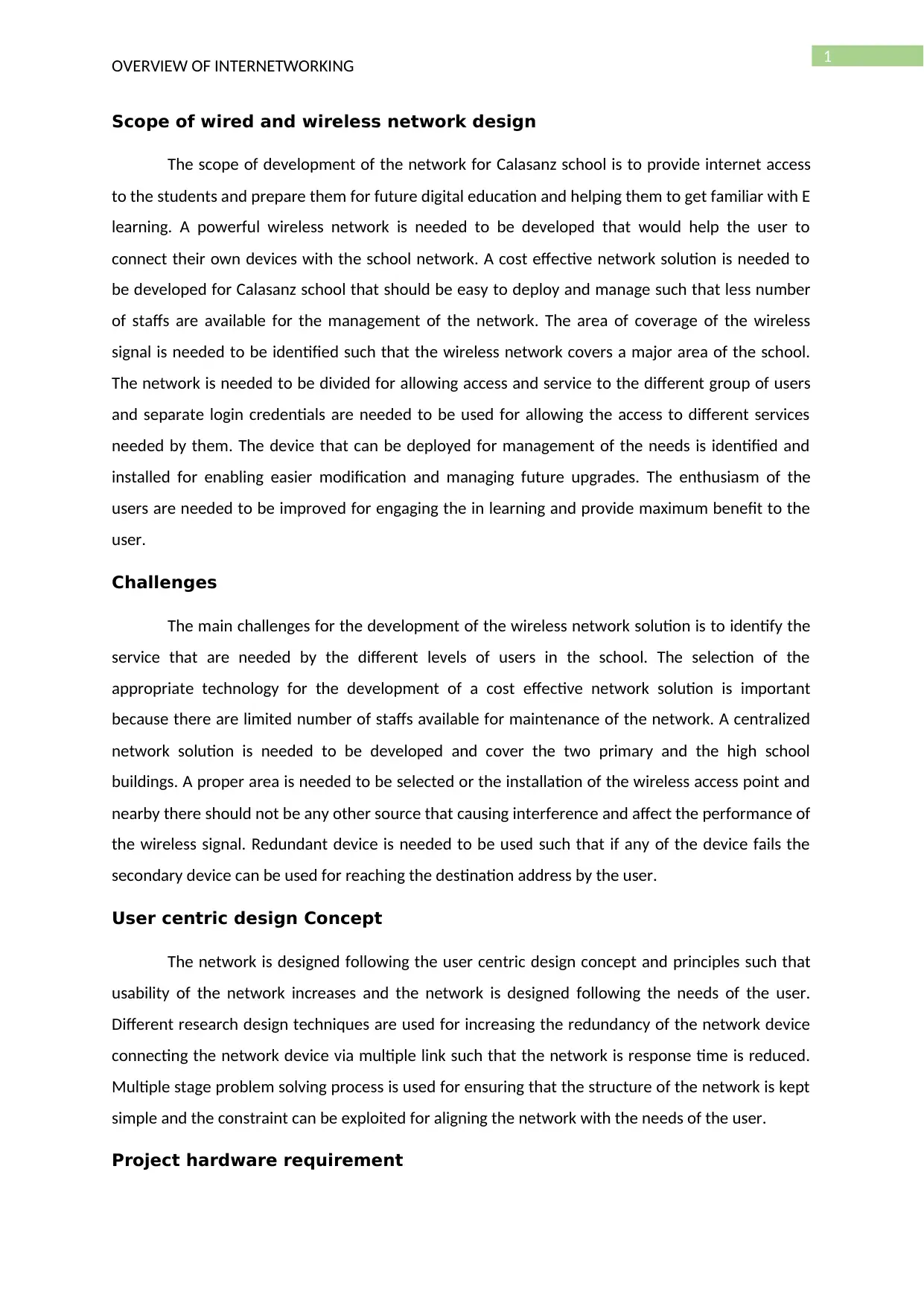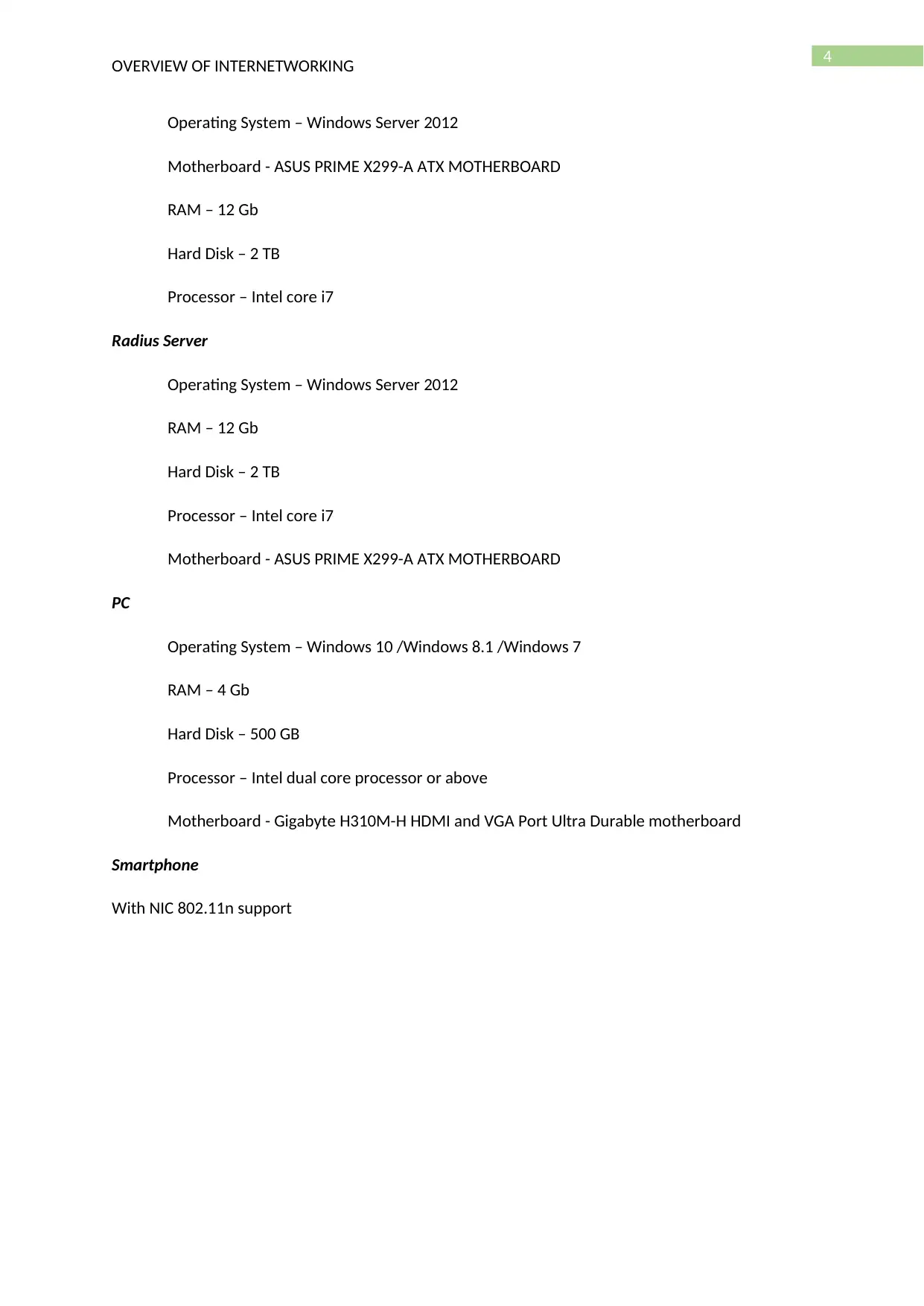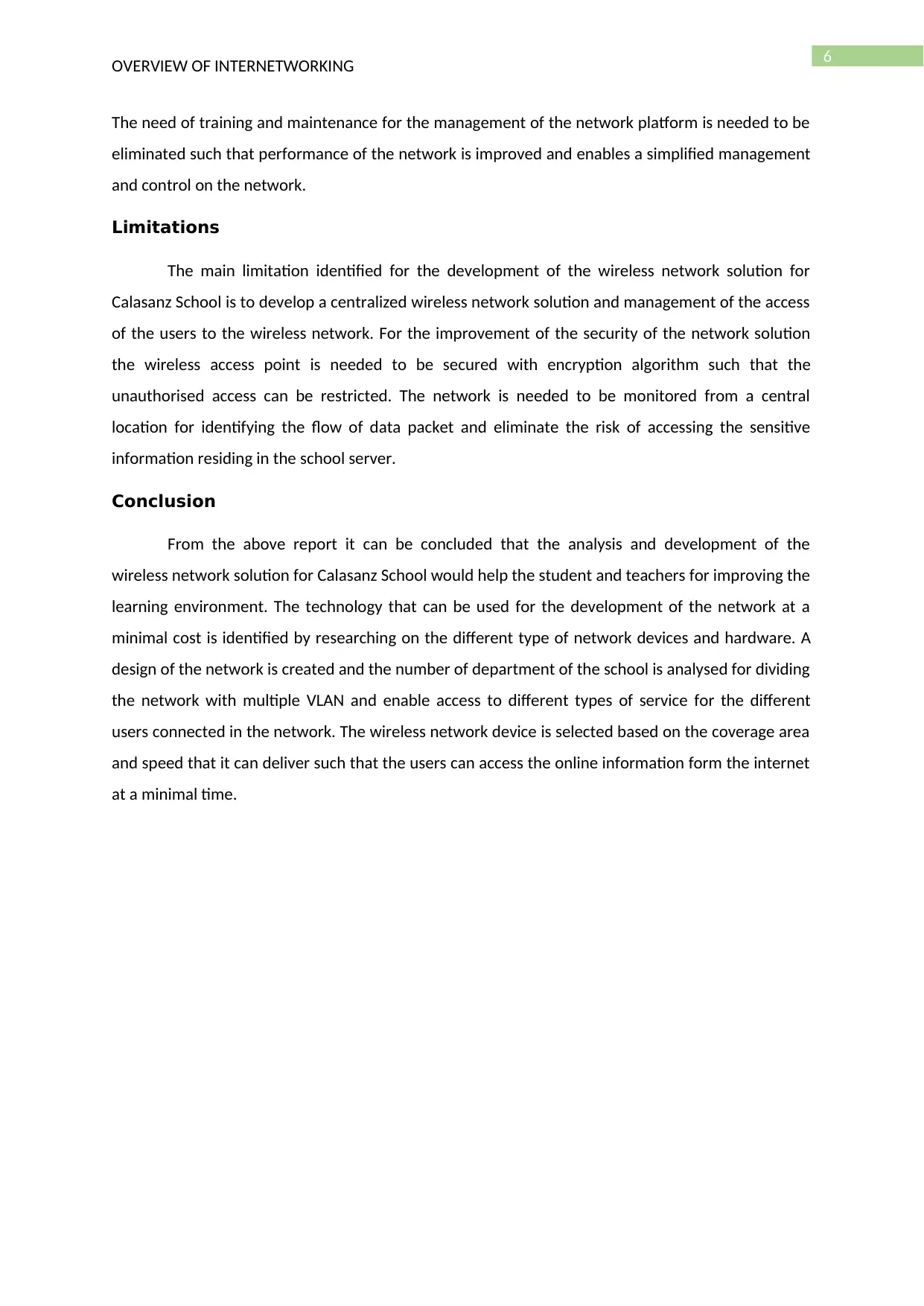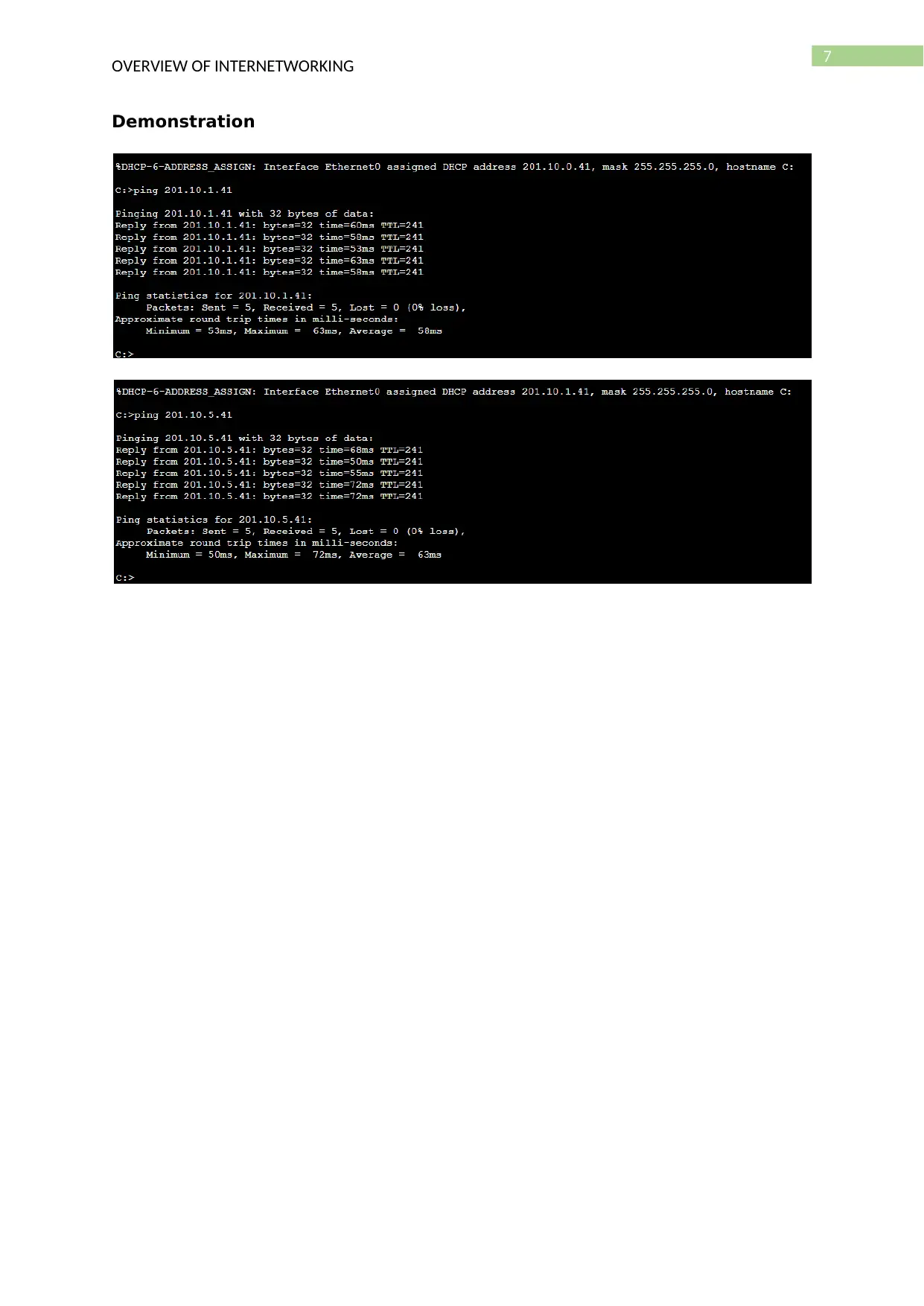Calasanz School: Network Requirement Analysis and Design Project
VerifiedAdded on 2023/02/01
|9
|1778
|20
Project
AI Summary
This project provides an overview of internetworking, focusing on the network design for Calasanz School. It begins with an analysis of the school's network requirements, emphasizing the need for a cost-effective and user-friendly wireless network to support digital education. The project addresses challenges such as identifying user needs and selecting appropriate technology, while adhering to a user-centric design concept. It outlines the hardware requirements, including switches, routers, cables, and servers, along with their specifications. The project also details the network design outcomes, including improved connectivity and the elimination of current issues, while also acknowledging the limitations such as the need for a centralized wireless solution. The project concludes with a demonstration and a bibliography of relevant sources. The project's goal is to create a robust and efficient network infrastructure that supports the school's educational goals.

Running head: OVERVIEW OF INTERNETWORKING
Network requirement analysis and plan
Name of the Student
Name of the University
Author’s Note
Network requirement analysis and plan
Name of the Student
Name of the University
Author’s Note
Paraphrase This Document
Need a fresh take? Get an instant paraphrase of this document with our AI Paraphraser

1
OVERVIEW OF INTERNETWORKING
Scope of wired and wireless network design
The scope of development of the network for Calasanz school is to provide internet access
to the students and prepare them for future digital education and helping them to get familiar with E
learning. A powerful wireless network is needed to be developed that would help the user to
connect their own devices with the school network. A cost effective network solution is needed to
be developed for Calasanz school that should be easy to deploy and manage such that less number
of staffs are available for the management of the network. The area of coverage of the wireless
signal is needed to be identified such that the wireless network covers a major area of the school.
The network is needed to be divided for allowing access and service to the different group of users
and separate login credentials are needed to be used for allowing the access to different services
needed by them. The device that can be deployed for management of the needs is identified and
installed for enabling easier modification and managing future upgrades. The enthusiasm of the
users are needed to be improved for engaging the in learning and provide maximum benefit to the
user.
Challenges
The main challenges for the development of the wireless network solution is to identify the
service that are needed by the different levels of users in the school. The selection of the
appropriate technology for the development of a cost effective network solution is important
because there are limited number of staffs available for maintenance of the network. A centralized
network solution is needed to be developed and cover the two primary and the high school
buildings. A proper area is needed to be selected or the installation of the wireless access point and
nearby there should not be any other source that causing interference and affect the performance of
the wireless signal. Redundant device is needed to be used such that if any of the device fails the
secondary device can be used for reaching the destination address by the user.
User centric design Concept
The network is designed following the user centric design concept and principles such that
usability of the network increases and the network is designed following the needs of the user.
Different research design techniques are used for increasing the redundancy of the network device
connecting the network device via multiple link such that the network is response time is reduced.
Multiple stage problem solving process is used for ensuring that the structure of the network is kept
simple and the constraint can be exploited for aligning the network with the needs of the user.
Project hardware requirement
OVERVIEW OF INTERNETWORKING
Scope of wired and wireless network design
The scope of development of the network for Calasanz school is to provide internet access
to the students and prepare them for future digital education and helping them to get familiar with E
learning. A powerful wireless network is needed to be developed that would help the user to
connect their own devices with the school network. A cost effective network solution is needed to
be developed for Calasanz school that should be easy to deploy and manage such that less number
of staffs are available for the management of the network. The area of coverage of the wireless
signal is needed to be identified such that the wireless network covers a major area of the school.
The network is needed to be divided for allowing access and service to the different group of users
and separate login credentials are needed to be used for allowing the access to different services
needed by them. The device that can be deployed for management of the needs is identified and
installed for enabling easier modification and managing future upgrades. The enthusiasm of the
users are needed to be improved for engaging the in learning and provide maximum benefit to the
user.
Challenges
The main challenges for the development of the wireless network solution is to identify the
service that are needed by the different levels of users in the school. The selection of the
appropriate technology for the development of a cost effective network solution is important
because there are limited number of staffs available for maintenance of the network. A centralized
network solution is needed to be developed and cover the two primary and the high school
buildings. A proper area is needed to be selected or the installation of the wireless access point and
nearby there should not be any other source that causing interference and affect the performance of
the wireless signal. Redundant device is needed to be used such that if any of the device fails the
secondary device can be used for reaching the destination address by the user.
User centric design Concept
The network is designed following the user centric design concept and principles such that
usability of the network increases and the network is designed following the needs of the user.
Different research design techniques are used for increasing the redundancy of the network device
connecting the network device via multiple link such that the network is response time is reduced.
Multiple stage problem solving process is used for ensuring that the structure of the network is kept
simple and the constraint can be exploited for aligning the network with the needs of the user.
Project hardware requirement

2
OVERVIEW OF INTERNETWORKING
Name of the Device Series Model Features and Ports
TP-LINK TL-SF1048 48-
Port 10/100Mbps,
Switch, 19-inch,
Rackmount, 9.6Gbps
Cap
TL-SF1000 Series TL-SF1048 48 10/100Mbps RJ45
ports
Supports MAC address
self-learning and auto
MDI/MDIX
Capacity 4.8 Gbps
TP-LINK Gigabit Load
Balance Broadband
Router TL-ER5120
TL-ER5000 Series TL-ER5120 Standards and
Protocols: IEEE 802.3,
802.3u, 802.3ab,
TCP/IP, DHCP, ICMP,
NAT, PPPoE, SNTP,
HTTP, DNS
Network Media:
10BASE-T: UTP
category 3, 4, 5 cable
(Max 100m),
100BASE-TX: UTP
category 5, 5e cable
(Max
100m), 000BASE-T:
UTP category 5, 5e
cable (Max 100m)
Interface: 1 Fixed
10/100/1000Mbps
WAN Port, 3 Free
Changeable
10/100/1000Mbps
WAN/LAN Ports, 1
Fixed
10/100/1000Mbps
LAN/DMZ Port, 1
Console Port (RJ-45
On RS232)
OVERVIEW OF INTERNETWORKING
Name of the Device Series Model Features and Ports
TP-LINK TL-SF1048 48-
Port 10/100Mbps,
Switch, 19-inch,
Rackmount, 9.6Gbps
Cap
TL-SF1000 Series TL-SF1048 48 10/100Mbps RJ45
ports
Supports MAC address
self-learning and auto
MDI/MDIX
Capacity 4.8 Gbps
TP-LINK Gigabit Load
Balance Broadband
Router TL-ER5120
TL-ER5000 Series TL-ER5120 Standards and
Protocols: IEEE 802.3,
802.3u, 802.3ab,
TCP/IP, DHCP, ICMP,
NAT, PPPoE, SNTP,
HTTP, DNS
Network Media:
10BASE-T: UTP
category 3, 4, 5 cable
(Max 100m),
100BASE-TX: UTP
category 5, 5e cable
(Max
100m), 000BASE-T:
UTP category 5, 5e
cable (Max 100m)
Interface: 1 Fixed
10/100/1000Mbps
WAN Port, 3 Free
Changeable
10/100/1000Mbps
WAN/LAN Ports, 1
Fixed
10/100/1000Mbps
LAN/DMZ Port, 1
Console Port (RJ-45
On RS232)
⊘ This is a preview!⊘
Do you want full access?
Subscribe today to unlock all pages.

Trusted by 1+ million students worldwide

3
OVERVIEW OF INTERNETWORKING
AC 5400 Wireless Tri-
Band MU-MIMO
Gigabit Router
Type of cables
Cat 6
Operating frequency 250 MHz
1000 Mbps network speeds for cable length of 100 meters
Applicable in 1000BaseTX networks
Applicable in 10GBase-T networks
Speeds of up to 10 GB/ ps up to 50 meters.
Cost (50 feet): 9 (USD)
Cat 5e
Operating frequency of 150MHz
1000 Mbps network speed
Cost (15.25m): 9.9 (USD)
Optical Fibre
50/125 optical fibre core/ cladding
1/10/40Gb Multimode
ceramic ferrule - 1.25mm
diameter cladding - 125μm
Fast Ethernet 100Basw-FX 2000m
40Gb Ethernet 40GBase-SR4 100m (330m QSFP+ eSR4)
Cost (3.28): 9.95 (USD)
Name of Server, PC with specification
Captive Portal Server
OVERVIEW OF INTERNETWORKING
AC 5400 Wireless Tri-
Band MU-MIMO
Gigabit Router
Type of cables
Cat 6
Operating frequency 250 MHz
1000 Mbps network speeds for cable length of 100 meters
Applicable in 1000BaseTX networks
Applicable in 10GBase-T networks
Speeds of up to 10 GB/ ps up to 50 meters.
Cost (50 feet): 9 (USD)
Cat 5e
Operating frequency of 150MHz
1000 Mbps network speed
Cost (15.25m): 9.9 (USD)
Optical Fibre
50/125 optical fibre core/ cladding
1/10/40Gb Multimode
ceramic ferrule - 1.25mm
diameter cladding - 125μm
Fast Ethernet 100Basw-FX 2000m
40Gb Ethernet 40GBase-SR4 100m (330m QSFP+ eSR4)
Cost (3.28): 9.95 (USD)
Name of Server, PC with specification
Captive Portal Server
Paraphrase This Document
Need a fresh take? Get an instant paraphrase of this document with our AI Paraphraser

4
OVERVIEW OF INTERNETWORKING
Operating System – Windows Server 2012
Motherboard - ASUS PRIME X299-A ATX MOTHERBOARD
RAM – 12 Gb
Hard Disk – 2 TB
Processor – Intel core i7
Radius Server
Operating System – Windows Server 2012
RAM – 12 Gb
Hard Disk – 2 TB
Processor – Intel core i7
Motherboard - ASUS PRIME X299-A ATX MOTHERBOARD
PC
Operating System – Windows 10 /Windows 8.1 /Windows 7
RAM – 4 Gb
Hard Disk – 500 GB
Processor – Intel dual core processor or above
Motherboard - Gigabyte H310M-H HDMI and VGA Port Ultra Durable motherboard
Smartphone
With NIC 802.11n support
OVERVIEW OF INTERNETWORKING
Operating System – Windows Server 2012
Motherboard - ASUS PRIME X299-A ATX MOTHERBOARD
RAM – 12 Gb
Hard Disk – 2 TB
Processor – Intel core i7
Radius Server
Operating System – Windows Server 2012
RAM – 12 Gb
Hard Disk – 2 TB
Processor – Intel core i7
Motherboard - ASUS PRIME X299-A ATX MOTHERBOARD
PC
Operating System – Windows 10 /Windows 8.1 /Windows 7
RAM – 4 Gb
Hard Disk – 500 GB
Processor – Intel dual core processor or above
Motherboard - Gigabyte H310M-H HDMI and VGA Port Ultra Durable motherboard
Smartphone
With NIC 802.11n support

5
OVERVIEW OF INTERNETWORKING
Network design in Netsim
Outcomes
The main outcomes of the networking project is to design a wired and wireless network
solution and gaining knowledge about the routing and switching technology and the elements that
are needed for the development of the network framework. It also helps in identifying the network
device that are required for the network development and rapidly deploy the solution without
effecting the teaching schedule of the school. The deployment of the network would also help to
create a strong and stable coverage of the WiFi signal and support education in multiple ways. The
student can find educational resources from any location in the school while connecting with the
wireless signal via different type of wireless devices such as smartphones, laptops, ipads and other
handheld devices. The connectivity issues that are currently faced by the user are eliminated with
the development of the network framework. The network is developed by configuring the switches
with VTP server and the layer 2 devices connected in the network are configured with vtp client such
that the VLAN information configured in the core switch is automatically transferred to the devices.
OVERVIEW OF INTERNETWORKING
Network design in Netsim
Outcomes
The main outcomes of the networking project is to design a wired and wireless network
solution and gaining knowledge about the routing and switching technology and the elements that
are needed for the development of the network framework. It also helps in identifying the network
device that are required for the network development and rapidly deploy the solution without
effecting the teaching schedule of the school. The deployment of the network would also help to
create a strong and stable coverage of the WiFi signal and support education in multiple ways. The
student can find educational resources from any location in the school while connecting with the
wireless signal via different type of wireless devices such as smartphones, laptops, ipads and other
handheld devices. The connectivity issues that are currently faced by the user are eliminated with
the development of the network framework. The network is developed by configuring the switches
with VTP server and the layer 2 devices connected in the network are configured with vtp client such
that the VLAN information configured in the core switch is automatically transferred to the devices.
⊘ This is a preview!⊘
Do you want full access?
Subscribe today to unlock all pages.

Trusted by 1+ million students worldwide

6
OVERVIEW OF INTERNETWORKING
The need of training and maintenance for the management of the network platform is needed to be
eliminated such that performance of the network is improved and enables a simplified management
and control on the network.
Limitations
The main limitation identified for the development of the wireless network solution for
Calasanz School is to develop a centralized wireless network solution and management of the access
of the users to the wireless network. For the improvement of the security of the network solution
the wireless access point is needed to be secured with encryption algorithm such that the
unauthorised access can be restricted. The network is needed to be monitored from a central
location for identifying the flow of data packet and eliminate the risk of accessing the sensitive
information residing in the school server.
Conclusion
From the above report it can be concluded that the analysis and development of the
wireless network solution for Calasanz School would help the student and teachers for improving the
learning environment. The technology that can be used for the development of the network at a
minimal cost is identified by researching on the different type of network devices and hardware. A
design of the network is created and the number of department of the school is analysed for dividing
the network with multiple VLAN and enable access to different types of service for the different
users connected in the network. The wireless network device is selected based on the coverage area
and speed that it can deliver such that the users can access the online information form the internet
at a minimal time.
OVERVIEW OF INTERNETWORKING
The need of training and maintenance for the management of the network platform is needed to be
eliminated such that performance of the network is improved and enables a simplified management
and control on the network.
Limitations
The main limitation identified for the development of the wireless network solution for
Calasanz School is to develop a centralized wireless network solution and management of the access
of the users to the wireless network. For the improvement of the security of the network solution
the wireless access point is needed to be secured with encryption algorithm such that the
unauthorised access can be restricted. The network is needed to be monitored from a central
location for identifying the flow of data packet and eliminate the risk of accessing the sensitive
information residing in the school server.
Conclusion
From the above report it can be concluded that the analysis and development of the
wireless network solution for Calasanz School would help the student and teachers for improving the
learning environment. The technology that can be used for the development of the network at a
minimal cost is identified by researching on the different type of network devices and hardware. A
design of the network is created and the number of department of the school is analysed for dividing
the network with multiple VLAN and enable access to different types of service for the different
users connected in the network. The wireless network device is selected based on the coverage area
and speed that it can deliver such that the users can access the online information form the internet
at a minimal time.
Paraphrase This Document
Need a fresh take? Get an instant paraphrase of this document with our AI Paraphraser

7
OVERVIEW OF INTERNETWORKING
Demonstration
OVERVIEW OF INTERNETWORKING
Demonstration

8
OVERVIEW OF INTERNETWORKING
Bibliography
[1] Huo, Ru, Fei Richard Yu, Tao Huang, Renchao Xie, Jiang Liu, Victor CM Leung, and Yunjie Liu.
"Software defined networking, caching, and computing for green wireless networks." IEEE
Communications Magazine 54, no. 11 (2016): 185-193.
[2] Baron, Loïc, Fadwa Boubekeur, Radomir Klacza, Mohammed Yasin Rahman, Ciro Scognamiglio,
Nina Kurose, Timur Friedman, and Serge Fdida. "OneLab: Major Computer Networking Testbeds for
IoT and Wireless Experimentation." In Proceedings of the 21st Annual International Conference on
Mobile Computing and Networking, pp. 199-200. ACM, 2015.
[3] Press, C. R. C. Wireless sensor networks: Current status and future trends. CRC press, 2016.
[4] Hail, Mohamed Ahmed, Marica Amadeo, Antonella Molinaro, and Stefan Fischer. "Caching in
named data networking for the wireless internet of things." In 2015 international conference on
recent advances in internet of things (RIoT), pp. 1-6. IEEE, 2015.
[5] Spiekermann, Daniel, and Tobias Eggendorfer. "Challenges of network forensic investigation in
virtual networks." Journal of Cyber Security and Mobility 5, no. 2 (2016): 15-46.
[6] Gupta, Sachin. "A Comparative Analysis of Wired and Wireless Network
Architecture." International Journal of Emerging Trends in Research 1, no. 1 (2016): 05-11.
[7] Li, Xiong, Jianwei Niu, Saru Kumari, Junguo Liao, and Wei Liang. "An enhancement of a smart card
authentication scheme for multi-server architecture." Wireless Personal Communications 80, no. 1
(2015): 175-192.
[8] Wang, Yingwei. "Cloud-dew architecture." International Journal of Cloud Computing 4, no. 3
(2015): 199-210.
[9] Simmons, J.M. Optical network design and planning. Springer., 2014.
[10] Tree, Star. "Wireless sensor networks." Self 1, no. R2 (2014): C0.
OVERVIEW OF INTERNETWORKING
Bibliography
[1] Huo, Ru, Fei Richard Yu, Tao Huang, Renchao Xie, Jiang Liu, Victor CM Leung, and Yunjie Liu.
"Software defined networking, caching, and computing for green wireless networks." IEEE
Communications Magazine 54, no. 11 (2016): 185-193.
[2] Baron, Loïc, Fadwa Boubekeur, Radomir Klacza, Mohammed Yasin Rahman, Ciro Scognamiglio,
Nina Kurose, Timur Friedman, and Serge Fdida. "OneLab: Major Computer Networking Testbeds for
IoT and Wireless Experimentation." In Proceedings of the 21st Annual International Conference on
Mobile Computing and Networking, pp. 199-200. ACM, 2015.
[3] Press, C. R. C. Wireless sensor networks: Current status and future trends. CRC press, 2016.
[4] Hail, Mohamed Ahmed, Marica Amadeo, Antonella Molinaro, and Stefan Fischer. "Caching in
named data networking for the wireless internet of things." In 2015 international conference on
recent advances in internet of things (RIoT), pp. 1-6. IEEE, 2015.
[5] Spiekermann, Daniel, and Tobias Eggendorfer. "Challenges of network forensic investigation in
virtual networks." Journal of Cyber Security and Mobility 5, no. 2 (2016): 15-46.
[6] Gupta, Sachin. "A Comparative Analysis of Wired and Wireless Network
Architecture." International Journal of Emerging Trends in Research 1, no. 1 (2016): 05-11.
[7] Li, Xiong, Jianwei Niu, Saru Kumari, Junguo Liao, and Wei Liang. "An enhancement of a smart card
authentication scheme for multi-server architecture." Wireless Personal Communications 80, no. 1
(2015): 175-192.
[8] Wang, Yingwei. "Cloud-dew architecture." International Journal of Cloud Computing 4, no. 3
(2015): 199-210.
[9] Simmons, J.M. Optical network design and planning. Springer., 2014.
[10] Tree, Star. "Wireless sensor networks." Self 1, no. R2 (2014): C0.
⊘ This is a preview!⊘
Do you want full access?
Subscribe today to unlock all pages.

Trusted by 1+ million students worldwide
1 out of 9
Related Documents
Your All-in-One AI-Powered Toolkit for Academic Success.
+13062052269
info@desklib.com
Available 24*7 on WhatsApp / Email
![[object Object]](/_next/static/media/star-bottom.7253800d.svg)
Unlock your academic potential
Copyright © 2020–2025 A2Z Services. All Rights Reserved. Developed and managed by ZUCOL.



